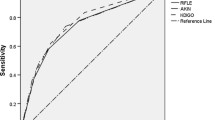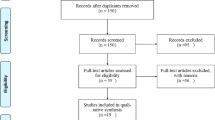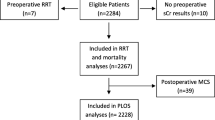Abstract
Purpose
Two previous classifications of acute kidney injury (AKI) have shown that AKI is associated with increased mortality. In 2012, Kidney Disease Improving Global Outcomes (KDIGO) created new AKI criteria by combining the two previous classifications. However, such combination might cause inconsistency among each definition in the criteria. We have investigated all the definitions in the new KDIGO criteria.
Methods
We retrospectively studied 767 adult patients whose stay in the ICU exceeded 24 h. The KDIGO criteria were applied to all patients to diagnose AKI. Hospital mortality of patients with AKI diagnosed by the ten definitions in the criteria was compared.
Results
AKI occurred in 51.9 % with the standard definition of KDIGO. By multivariable analysis, odds ratios were increased with AKI stage progression and AKI stage 3 was significantly associated with hospital mortality. Crude hospital mortality stratified by the ten definitions showed increasing trends with stage progression. Mortality of the three definitions in stage 1 was from 4.0 to 10.8 %. Stage 2 had two definitions and their mortality was 13.6 and 17.6 %. Stage 3 had five definitions and their mortality ranged from 27.6 to 55.6 %.
Conclusion
AKI defined by the new KDIGO criteria was associated with increased hospital mortality. Although definitions in the KDIGO criteria seem to be appropriate because of the clear relationship between mortality and stage progression on the whole, several limitations may exist, especially in stage 3. Further research should be needed to clarify the validity of the KDIGO criteria and the detailed categories.



Similar content being viewed by others
Abbreviations
- KDIGO:
-
Kidney Disease Improving Global Outcomes
- AKI:
-
Acute kidney injury
- RIFLE:
-
Risk, injury, failure, loss and end-stage kidney disease
- AKIN:
-
Acute Kidney Injury Network
- ICU:
-
Intensive care unit
- ADQI:
-
Acute Dialysis Quality Initiative
- APACHE:
-
Acute physiology and chronic health evaluation
- MDRD:
-
Modification of diet in renal disease
- CKD:
-
Chronic kidney disease
- RRT:
-
Renal replacement therapy
- ARDS:
-
Acute respiratory distress syndrome
- AECC:
-
American-European consensus conference
References
Uchino S, Kellum JA, Bellomo R, Doig GS, Morimatsu H, Morgera S, Schetz M, Tan I, Bouman C, Macedo E, Gibney N, Tolwani A, Ronco C; Beginning and ending supportive therapy for the kidney (BEST Kidney) investigators. Acute renal failure in critically ill patients: a multinational, multicenter study. JAMA. 2005;294:813–8.
Bellomo R, Ronco C, Kellum JA, Mehta RL, Palevsky P. Acute renal failure—definition, outcome measures, animal models, fluid therapy and information technology needs: the Second International Consensus Conference of the Acute Dialysis Quality Initiative (ADQI) Group. Crit Care. 2004;8:R204–12.
Mehta RL, Kellum JA, Shah SV, Molitoris BA, Ronco C, Warnock DG, Levin A. Acute Kidney Injury Network: report of an initiative to improve outcomes in acute kidney injury. Crit Care. 2007;11:R31.
Cruz DN, Ricci Z, Ronco C. Clinical review: RIFLE and AKIN—time for reappraisal. Crit Care. 2009;13:211.
Ricci Z, Cruz D, Ronco C. The RIFLE criteria and mortality in acute kidney injury: a systematic review. Kidney Int. 2008;73:538–46.
Bagshaw SM, George C, Bellomo R. A comparison of the RIFLE and AKIN criteria for acute kidney injury in critically ill patients. Nephrol Dial Transplant. 2008;23:1569–74.
Lopes JA, Fernandes P, Jorge S, Goncalves S, Alvarez A, Costa e Silva Z, Franca C, Prata MM. Acute kidney injury in intensive care unit patients: a comparison between the RIFLE and the Acute Kidney Injury Network classifications. Crit Care. 2008;12:R110.
Ostermann M, Chang R. Correlation between the AKI classification and outcome. Crit Care. 2008;12:R144.
Joannidis M, Metnitz B, Bauer P, Schusterschitz N, Moreno R, Druml W, Metnitz PG. Acute kidney injury in critically ill patients classified by AKIN versus RIFLE using the SAPS 3 database. Intensive Care Med. 2009;35:1692–702.
Englberger L, Suri RM, Li Z, Casey ET, Daly RC, Dearani JA, Schaff HV. Clinical accuracy of RIFLE and Acute Kidney Injury Network (AKIN) criteria for acute kidney injury in patients undergoing cardiac surgery. Crit Care. 2011;15:R16.
Mandelbaum T, Scott DJ, Lee J, Mark RG, Malhotra A, Waikar SS, Howell MD, Talmor D. Outcome of critically ill patients with acute kidney injury using the Acute Kidney Injury Network criteria. Crit Care Med. 2011;39:2659–64.
Han SS, Kang KJ, Kwon SJ, Wang SJ, Shin SH, Oh SW, Na KY, Chae DW, Kim S, Chin HJ. Additional role of urine output criterion in defining acute kidney injury. Nephrol Dial Transplant. 2012;27:161–5.
Selby NM, Crowley L, Fluck RJ, McIntyre CW, Monaghan J, Lawson N, Kolhe NV. Use of electronic results reporting to diagnose and monitor AKI in hospitalized patients. Clin J Am Soc Nephrol. 2012;7:533–40.
Stewart IJ, Tilley MA, Cotant CL, Aden JK, Gisler C, Kwan HK, McCorcle J, Renz EM, Chung KK. Association of AKI with adverse outcomes in burned military casualties. Clin J Am Soc Nephrol. 2012;7:199–206.
Nisula S, Kaukonen KM, Vaara ST, Korhonen AM, Poukkanen M, Karlsson S, Haapio M, Inkinen O, Parviainen I, Suojaranta-Ylinen R, Laurila JJ, Tenhunen J, Reinikainen M, Ala-Kokko T, Ruokonen E, Kuitunen A, Pettilä V; FINNAKI Study Group. Incidence, risk factors and 90-day mortality of patients with acute kidney injury in Finnish intensive care units: the FINNAKI study. Intensive Care Med. 2013;39:420–8.
Bagshaw SM, George C, Dinu I, Bellomo R. A multi-centre evaluation of the RIFLE criteria for early acute kidney injury in critically ill patients. Nephrol Dial Transplant. 2008;23:1203–10.
KDIGO Clinical practice guideline for acute kidney injury. Kidney Int. Supplements. 2012;2:1–141.
Knaus WA, Draper EA, Wagner DP, Zimmerman JE. APACHE II: a severity of disease classification system. Crit Care Med. 1985;13:818–29.
Foundation NK. K/DOQI clinical practice guidelines for chronic kidney disease: evaluation, classification and stratification. Am J Kidney Dis. 2002;39(2 Suppl 1):S76–92.
Matsuo S, Imai E, Horio M, Yasuda Y, Tomita K, Nitta K, Yamagata K, Tomino Y, Yokoyama H, Hishida A. Revised equations for estimated GFR from serum creatinine in Japan. Am J Kidney Dis. 2009;53:982–92.
Kanda Y. Investigation of the freely available easy-to-use software ‘EZR’ for medical statistics. Bone Marrow Transplant. 2013;48:452–8.
Luo X, Jiang L, Du B, Wen Y, Wang M, Xi X; Beijing Acute Kidney Injury Trial (BAKIT) workgroup. A comparison of different diagnostic criteria of acute kidney injury in critically ill patients. Crit Care. 2014;18:R144.
Chertow GM, Burdick E, Honour M, Bonventre JV, Bates DW. Acute kidney injury, mortality, length of stay, and costs in hospitalized patients. J Am Soc Nephrol. 2005;16:3365–70.
Lassnigg A, Schmidlin D, Mouhieddine M, Bachmann LM, Druml W, Bauer P, Hiesmayr M. Minimal changes of serum creatinine predict prognosis in patients after cardiothoracic surgery: a prospective cohort study. J Am Soc Nephrol. 2004;15:1597–605.
Lassnigg A, Schmid ER, Hiesmayr M, Falk C, Druml W, Bauer P, Schmidlin D. Impact of minimal increases in serum creatinine on outcome in patients after cardiothoracic surgery: do we have to revise current definitions of acute renal failure? Crit Care Med. 2008;36:1129–37.
Macedo E, Malhotra R, Bouchard J, Wynn SK, Mehta RL. Oliguria is an early predictor of higher mortality in critically ill patients. Kidney Int. 2011;80:760–7.
Angus DC. The acute respiratory distress syndrome: whatʼs in a name? JAMA. 2012;307:2542–4.
Bernard GR, Artigas A, Brigham KL, Carlet J, Falke K, Hudson L, Lamy M, Legall JR, Morris A, Spragg R. The American-European Consensus Conference on ARDS. Definitions, mechanisms, relevant outcomes, and clinical trial coordination. Am J Respir Crit Care Med. 1994;149:818–824.
Ranieri VM, Rubenfeld GD, Thompson BT, Ferguson ND, Caldwell E, Fan E, Camporota L, Slutsky AS. Acute respiratory distress syndrome: the Berlin definition. JAMA. 2012;307:2526–33.
Acknowledgments
We thank the electronic medical record team in Jikei University School of Medicine for their contribution to this study. The authors declare no financial support or sponsorship.
Author information
Authors and Affiliations
Corresponding author
Ethics declarations
Conflict of interest
On behalf of all authors, the corresponding author states that there is no conflict of interest.
About this article
Cite this article
Izawa, J., Uchino, S. & Takinami, M. A detailed evaluation of the new acute kidney injury criteria by KDIGO in critically ill patients . J Anesth 30, 215–222 (2016). https://doi.org/10.1007/s00540-015-2109-6
Received:
Accepted:
Published:
Issue Date:
DOI: https://doi.org/10.1007/s00540-015-2109-6




